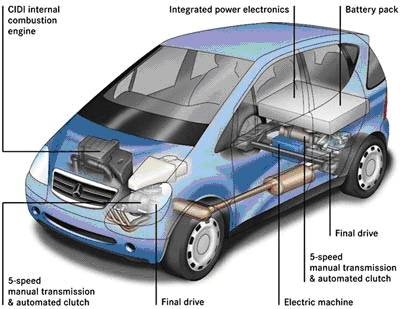
Hybrid electric vehicles combine an electric motor, battery and power system with an internal combustion engine to achieve better fuel economy and reduce toxic emissions. Hybrid electric vehicles, or HEVs, have existed since the 1800s, but only through recent advances have they become viable transportation alternatives as the technology they use can now be mass produced as an affordable vehicle. The HEV provides its owner with advantages in fuel economy and environmental impact over conventional automobiles.
Hybrid electric vehicles are not a recent invention. Although there were earlier HEVs built, it wasn't until 1905 that the American Engineer, H. Piper, filed for a patent to add an additional electric engine to a gasoline combustion engine in order to speed the engine's acceleration capabilities. By the time this patent was approved, the gasoline combustion engine had evolved to achieve the desired acceleration rate without the additional electric support and interest in the idea waned. Henry Ford's development and implementation of the assembly line to produce gasoline powered engine further destroyed interest in developing a Hybrid Electric Engine.
In 1931, the German inventor, Erich Gaichen, built a Hybrid Electric Vehicle that introduced a recharging technology that is still in use today in Toyota's Prius design, Gaichen's HEV would recharge itself as it went down hill, foreshadowing the regenerative braking system (RESS) found in the Prius and other modern HEVs.
A resurgence of interest in hybrid vehicles occurred in the USA in the 1960's when Congress began to see bills introduced that suggested that producing HEVs would help cut air pollution. By 1970, General Motors had developed a hybrid electric vehicle prototype that used electric power up to 13 mpg and then switched to gasoline power. In 1993, the Department of Energy introduced the HEV program that created a partnership with the three largest U.S. automakers to develop Hybrid Electric Vehicles with a goal to have realistic models by the year 2000, and usable, low cost vehicles available to the public by 2003. Despite efforts by all three automakers, as well as other car manufacturers during the 80's and early 90's, the public remained unenthusiastic about the electric vehicles introduced into the market.
Not until the late 1990's, with the introduction of the Honda Insight and Toyota Prius, did HEVs become viable products on the market.

While all hybrid electric vehicles combine electric engine with a combustion engine of some other fuel type, there are only two different ways in which automakers are approaching using the electricity generated in moving the car. The first is to feed the electric power directly into the engine as it is created, supplementing the power and requiring less use of fuel to power the engine; and the second is use the combustion engine to power a generator that then recharges the car's batteries for use when the combustion engine is turned off and the car is driving on electric power alone.
A hybrid electric vehicle produces far less toxic emissions then standard gasoline only vehicles. The Toyota Prius, for example, has 90% less emissions then a comparably sized conventional car. The use of the electric motor for propulsion in low speed environments and the technology that allows a HEV to turn off the combustion engine when idling greatly reduces the emissions from the vehicle. Hybrid electric vehicles use smaller engines than conventional automobiles and have less moving parts that are prone to wearing out and creating waste. The most attractive environmental advantage to an HEV is the increased fuel efficiency of these types of vehicles. For most consumers, this is the most important advantage of all during times of high fuel prices and the environmental benefit of the vehicle consuming less fossil fuel often goes unrecognized.
In many countries and cities, hybrid electric vehicles are given special advantages over conventional vehicles. In 2005, President Bush signed a bill allowing tax credits for the purchase of new electric hybrid vehicles, in addition to other tax discounts offered by states for the purchase of HEVs. Many cities in the USA waive parking fees, allow HEVs to use carpool lanes without restrictions, and try to initiate other benefits to encourage the use of hybrid electric vehicles. In Albuquerque, New Mexico, Mayor Chavez passed a city ordinance that allowed any HEV to park without having to pay into the city's parking meters. Yet again, it is the fuel efficiency of these vehicles that draws so many consumers. As oil prices rise, effecting the cost of a gallon of gasoline, more and more people see the advantage of driving a car that was designed to get the maximum mileage out of a gallon of gas. The cost savings for a commuter can be very large.
Now that the major automakers have mastered the mass production of a hybrid electric vehicles and found a demand for such vehicles, they are continuing to pursue research in order to bring the technology to all types of vehicles, making the HEV the standard engine in all sedans, SUVs and sports cars. This would not only dramatically reduce the amount of toxic emissions released into the earth's atmosphere globally, but opens the doors to providing funding to research a variety of alternative fuel sources. The proven success of the hybrid electric vehicle reignites interest in developing other alternative fuel sources and potentially, lessening or eliminating our global dependence on fossil fuel.
